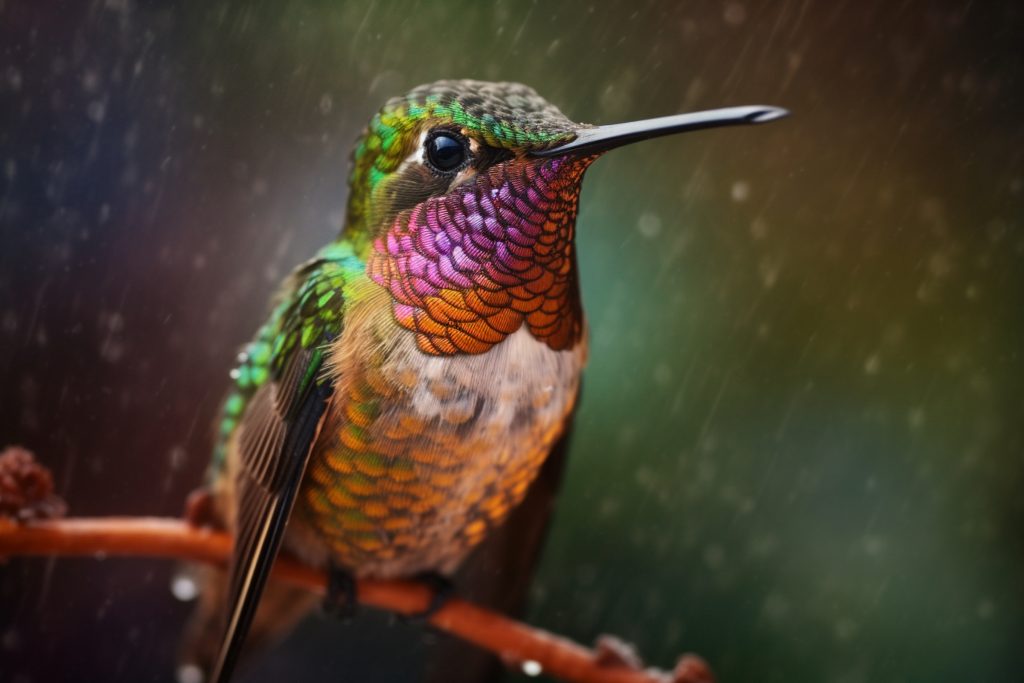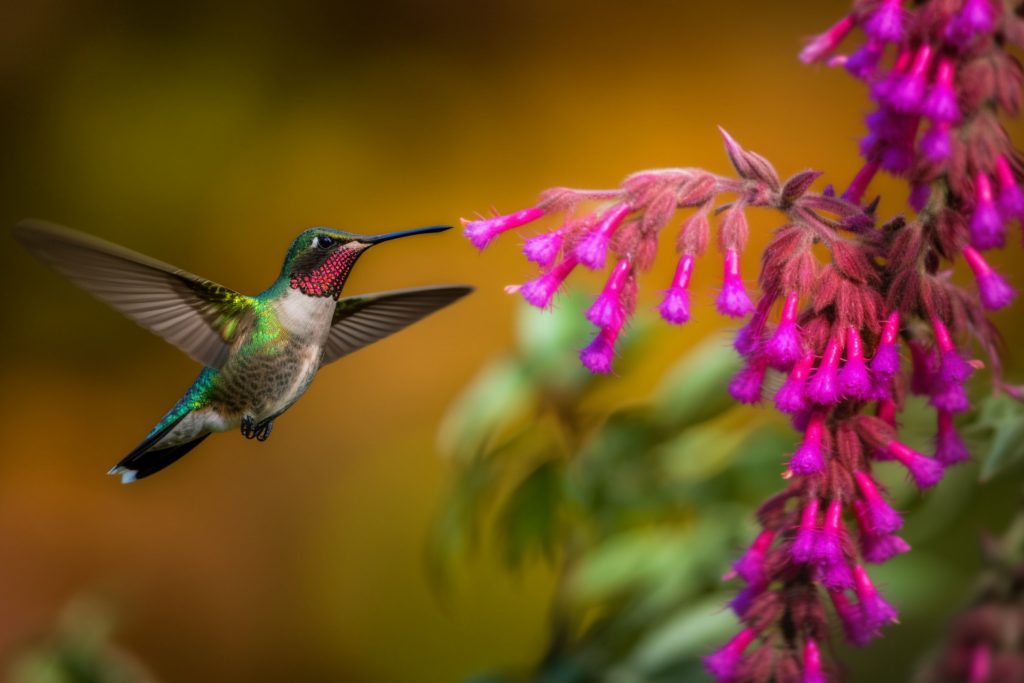Are there hummingbirds in Alaska? Yes, there are! Although it may come as a surprise, a few hardy species of hummingbirds do indeed grace the skies of Alaska during the warmer months.
In this blog post, we’ll explore the fascinating world of hummingbirds in Alaska, including the species that can be found there, their incredible migratory journeys, and the unique adaptations that enable them to survive in this often harsh and unforgiving landscape.
We’ll also discuss the importance of hummingbirds in Alaskan ecosystems and share some tips for attracting these remarkable creatures to your own garden.
- The Hummingbirds of Alaska: Resilient Avian Visitors
- The Long Journey: Migration of Alaskan Hummingbirds
- Survival Strategies: Hummingbirds in the Alaskan Wilderness
- The Ecological Role of Hummingbirds in Alaska
- Attracting Hummingbirds to Your Alaskan Garden
- Conclusion: Celebrating the Resilience of Alaskan Hummingbirds
Related post to read: 15 Best Hummingbird Feeders Compared.

The Hummingbirds of Alaska: Resilient Avian Visitors
While Alaska might not be the first place that comes to mind when you think of hummingbirds, several species do visit the state during the warmer months. The most common of these is the Rufous Hummingbird and Anna’s Hummingbird.
Rufous Hummingbirds
The Rufous Hummingbird (Selasphorus rufus) is the most frequently observed species in Alaska. These tiny, feisty birds are characterised by their bright orange and iridescent green plumage and are known for their incredible endurance and agility.
The Rufous Hummingbird’s range extends from Mexico to Alaska, and they are known to breed as far north as southern Alaska. They can be found in a variety of habitats, including forests, meadows, and gardens, where they are drawn to colourful, nectar-producing flowers.
Anna’s Hummingbirds
Anna’s Hummingbirds (Calypte anna) are slightly larger than Rufous Hummingbirds and are identifiable by their iridescent green backs, greyish-white bellies, and the males’ vibrant magenta throat feathers. Though primarily found along the western coast of North America, small numbers of Anna’s Hummingbirds have been known to venture into Alaska, particularly in the southeastern regions.
The Long Journey: Migration of Alaskan Hummingbirds
The presence of hummingbirds in Alaska is a testament to their remarkable migratory abilities. These tiny birds undertake epic journeys every year, travelling thousands of miles between their breeding and wintering grounds.
Rufous Hummingbird Migration
Rufous Hummingbirds have one of the longest migratory routes of any hummingbird species, travelling over 3,000 miles (4,800 kilometres) between their wintering grounds in Mexico and their breeding grounds in the Pacific Northwest and Alaska. Their migration is a round-trip journey that takes them through a wide range of habitats and climatic conditions, showcasing their incredible endurance and adaptability.
Anna’s Hummingbird Migration
While Anna’s Hummingbirds are not as migratory as Rufous Hummingbirds, they still undertake seasonal movements in response to changing environmental conditions. Some populations of Anna’s Hummingbirds will move northward during the warmer months, with a small number reaching Alaska.
Survival Strategies: Hummingbirds in the Alaskan Wilderness
For hummingbirds, surviving in Alaska’s often harsh and unpredictable environment requires a unique set of adaptations and behaviours. These remarkable birds have evolved several strategies to help them thrive in the Last Frontier.
Energy Conservation
As nectar-feeders, hummingbirds require a constant supply of high-energy food to maintain their rapid metabolism. In Alaska, where food resources can be scarce, hummingbirds must be especially efficient at conserving energy. They do this by entering a state called torpor, which is a form of short-term hibernation. During torpor, a hummingbird’s metabolic rate, heart rate, and body temperature are significantly reduced, allowing them to conserve energy during periods of inactivity, such as cold nights or when food is scarce. This ability to enter torpor is critical for hummingbirds’ survival in Alaska’s challenging environment.
Nectar and Insect Foraging
To fuel their high-energy lifestyles, hummingbirds in Alaska must be adept at locating and consuming nectar-rich flowers and small insects. They are known to feed on a wide variety of native plants, such as fireweed, columbine, and red elderberry, as well as insects like mosquitoes, gnats, and fruit flies. By exploiting diverse food sources, hummingbirds can maintain their energy reserves even in the face of fluctuating environmental conditions.
Breeding and Nesting Habits
Hummingbirds in Alaska have adapted their breeding habits to make the most of the short Alaskan summer. They typically arrive in the state around May, and their breeding season usually lasts until August. During this time, they build small, cup-shaped nests using plant materials like lichen, moss, and spider silk. These nests are often placed on the branches of trees or shrubs, providing shelter and protection from predators and the elements.
The Ecological Role of Hummingbirds in Alaska
Despite their small size, hummingbirds play a significant role in the ecosystems they inhabit. As pollinators, they are vital for the reproduction of many plant species, transferring pollen from one flower to another as they feed on nectar. In Alaska, hummingbirds are particularly important for the pollination of native wildflowers, which in turn provide food and habitat for other wildlife. By pollinating plants, hummingbirds contribute to the overall health and diversity of Alaskan ecosystems.

Attracting Hummingbirds to Your Alaskan Garden
If you’re fortunate enough to live in Alaska and would like to attract hummingbirds to your garden, there are several steps you can take to create a welcoming environment for these avian visitors:
- Plant a variety of nectar-producing flowers: Hummingbirds are attracted to brightly coloured flowers, particularly red, orange, and pink ones. Planting a mix of native and non-native flowering plants, such as bee balm, foxglove, and salvia, will provide a rich source of nectar for hummingbirds throughout the summer months.
- Provide a source of clean water: Like all birds, hummingbirds need access to clean water for drinking and bathing. Installing a shallow birdbath or a small pond in your garden will help meet this need.
- Avoid using pesticides: Chemical pesticides can harm or kill hummingbirds and the insects they feed on. Opting for natural pest control methods, such as encouraging beneficial insects or using physical barriers, will help protect hummingbirds and other wildlife in your garden.
- Install a hummingbird feeder: Supplementing natural food sources with a hummingbird feeder can be an effective way to attract these birds to your garden. Fill the feeder with a mixture of one part sugar to four parts water, and be sure to clean and refill it regularly to prevent mould and bacteria growth.
Conclusion: Celebrating the Resilience of Alaskan Hummingbirds
The presence of hummingbirds in Alaska is a testament to their remarkable resilience and adaptability. These tiny, vibrant creatures have overcome significant challenges to thrive in the Last Frontier, enriching the lives of those who are fortunate enough to witness their dazzling displays of agility and beauty.
As we celebrate the wonder of hummingbirds in Alaska, let us also remember our responsibility to protect and preserve the fragile ecosystems they inhabit.
By taking simple steps to create welcoming environments for these avian gems, we can help ensure that future generations will have the opportunity to experience the magic of hummingbirds in the wild.
Related Posts to Read:
- Are There Hummingbirds In Africa?
- Are There Hummingbirds in Europe?
- Are There Hummingbirds in Australia?
- Are There Hummingbirds In Florida?
- Are There Hummingbirds In Massachusetts?
- Are There Hummingbirds In Michigan?
- Are There Hummingbirds In Texas?
- Are There Hummingbirds In New Jersey?
- Are There Hummingbirds In New York?
- Are There Hummingbirds In Mexico?
References:
- About Hummingbird (Wikipedia).
- About Alaska (Wikipedia)
- About Alaska Department of Fish and Game: Bird Viewing.
- Greenewalt, C. H. (1960). Hummingbirds. New York: Doubleday. Google Scholar.
